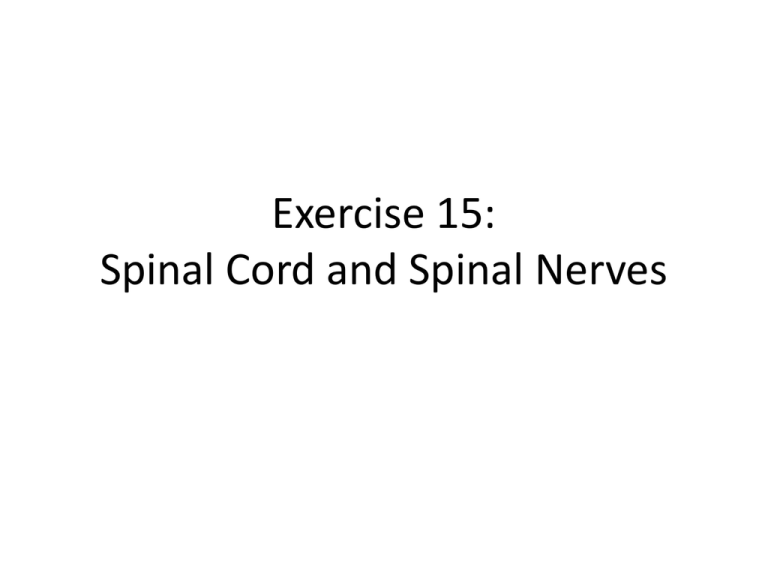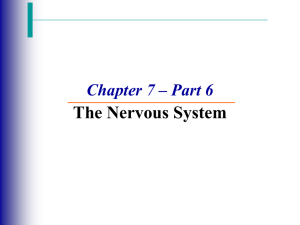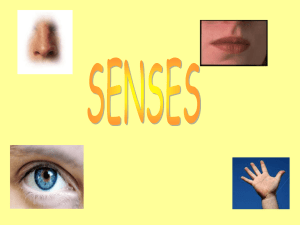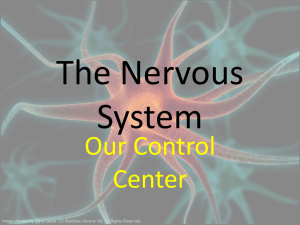Exercise 15: Spinal Cord and Spinal Nerves
advertisement

Exercise 15: Spinal Cord and Spinal Nerves 1. Spinal Cord • Extends from the foramen magnum of the skull to the first or second lumbar vertebra (L1& L2) • 31 pairs of spinal nerves arise from the spinal cord • Cauda equina is a collection of spinal nerves at the inferior end The cord does not extend the entire length of the vertebral column – so a group of nerves leaves the inferior spinal cord and extends downward. It resembles a horses tail and is called the cauda equina 2. Spinal Cord Anatomy Figure 7.21 2. Another spinal cord picture Dorsal ramus of spinal nerve Ventral ramus of spinal nerve The Spinal Nerves- immediately after being formed the spinal nerves split into dorsal and ventral rami. Figure 7.25b 3. Gross Anatomy of Spinal Cord • Thicker at the neck and end of the cord (cervical and lumbar enlargements) • Reason: large group of nerves leave the cord to serve the arms and legs . Spinal Cord Anatomy • Meninges cover the spinal cord • Spinal nerves leave at the level of each vertebrae – Dorsal root • Associated with the dorsal root ganglia—collections of cell bodies outside the central nervous system – Ventral root • Contains axons Spinal Cord Anatomy • Internal gray matter is mostly cell bodies – Dorsal (posterior) horns – Anterior (ventral) horns – Gray matter surrounds the central canal • Central canal is filled with cerebrospinal fluid • Exterior white mater— conduction tracts – Dorsal, lateral, ventral columns Up close view of cervical enlargement Spinal Cord Anatomy Figure 7.20 (1 of 2) Up close view of lumbar enlargement Spinal Cord Anatomy Figure 7.20 (2 of 2) Spinal Nerves and Nerve Plexuses 4. Spinal Nerves • 31 nerves connecting the spinal cord and various body regions. • 8 paired cervical nerves • 12 paired thoracic nerves • 5 paired lumbar nerves • 5 paired sacral nerves • 1 pair of coccygeal nerves Spinal Nerves • There is a pair of spinal nerves at the level of each vertebrae for a total of 31 pairs • Formed by the combination of the ventral and dorsal roots of the spinal cord • Named for the region from which they arise Figure 7.25a 5.Anatomy of Spinal Nerves • Spinal nerves divide soon after leaving the spinal cord – Dorsal rami—serve the skin and muscles of the posterior trunk – Ventral rami—form a complex of networks (plexus) for the anterior 5.& 7. Plexuses Plexus- ventral rami C1-T1 and T12-S4 branch extensively and join one another lateral to the vertebral column forming complicated nerve plexuses that serve motor and sensory needs ***Except for T2 to T12, Ventral Rami from C1- T1 form Cervical & Brachial plexuses Ventral rami from L1-S4 form Lumbar and Sacral plexuses 6. Serve motor and sensory needs of the limbs Ventral rami from T2-T12 do not form plexuses..they serve the muscles of intercostal spaces and the skin and muscles of the anterior and lateral trunk Sacral Plexus This diagram shows the nerves leaving from the vertebral canal Note: There are 7 cervical vertebrae but 8 pairs of cervical nerves. C1 – C7 emerge above the vertebrae for which they are named. C8 emerges between C7 and T1. The remaining spinal nerve pairs emerge below the same numbered vertebra. PNS: The Spinal Nerves Look how the dorsal and ventral roots merge to form the spinal nerve then split again to form the ventral and dorsal rami Figure 7.25b Table 7.2 (1 of 2) Table 7.2 (2 of 2) 6. Spinal Nerves • Each connects to the spinal cord by 2 roots – dorsal and ventral. • Ventral roots are motor while dorsal roots are sensory. 6. Dorsal root – sensory function Ventral root – motor function Dorsal Root Figure 7.22 Ventral root Dorsal root – sensory function Ventral root – motor function Important nerve= phrenic nerve which serves the diaphragm and muscles of shoulder and neck Major Peripheral Nerves of the Upper Limbs The brachial plexus branches into 5 major peripheral nerves of the upper limbs : • Axillary • Radial • Median • Musculocutaneous • Ulnar Figure 7.26a Major Peripheral Nerves of the Lower Limbs The nerves from the lumbar plexus serve the abdominal region and the anteromedial thigh. Important nerves: • Femoral • Obturator Figure 7.26b Major Peripheral Nerves Lower Limbs Sacral plexus – supply buttock, posterior thigh, and almost all leg and foot. Important Nerves: • The sciatic nerve – largest nerve in the body; divides into common fibular nerve and tibial nerve. • Superior and Inferior Gluteal Figure 7.26c 8. Table 7.2 (2 of 2) Extra/ More information on the brain Spinal Cord • Functions to transmit messages to and from the brain (white matter) and to serve as a reflex center (gray matter). • extends about 17” • diameter of your thumb • Thicker at the neck and end of the cord (cervical and lumbar enlargements) b/c of the large group of nerves connecting these regions of the cord w/ the arms and legs. Spinal Cord • The cord does not extend the entire length of the vertebral column – so a group of nerves leaves the inferior spinal cord and extends downward. It resembles a horses tail and is called the cauda equina. Spinal Cord • Notice the gross features of the spinal cord on the right. • 31 pairs of spinal nerves attach to the cord by paired roots and exit from the vertebral canal via the intervertebral foramina. Cross Sectional Anatomy of the Spinal Cord • Flattened from front to back. • Anterior median fissure and posterior median sulcus partially divide it into left and right halves. • Gray matter is in the core of the cord and surrounded by white matter. • Resembles a butterfly. • 2 lateral gray masses connected by the gray commissure. • Posterior projections are the posterior or dorsal horns. • Anterior projections are the anterior or ventral horns. • In the thoracic and lumbar cord, there also exist lateral horns. Gray Matter • Posterior horns contain interneurons. • Anterior horns contain some • interneurons as well as the cell bodies of motor neurons. – These cell bodies project their axons via the ventral roots of the spinal cord to the skeletal muscles. – The amount of ventral gray matter at a given level of the spinal cord is proportional to the amount of skeletal muscle innervated. Gray Matter • Lateral horn neurons are sympathetic motor neurons serving visceral organs. – Their axons also exit via the ventral root. • Afferent sensory fibers carrying info from peripheral receptors form the dorsal roots of the spinal cord. The somata of these sensory fibers are found in an enlargement known as a dorsal root ganglion. • The dorsal and ventral roots fuse to form spinal nerves. White Matter • Myelinated nerve fibers. • Allows for communication btwn the brain and spinal cord or btwn different regions of the spinal cord. • White matter on each side of the cord is divided into columns or funiculi. – Typically, they are ascending or descending. • What does that mean? Spinal Nerves • The 2 roots join to form a spinal nerve prior to exiting the vertebral column. • Roots are short and horizontal in the cervical and thoracic regions while they are longer and more horizontal in the sacral and lumbar regions. • Almost immediately after emerging from its intervertebral foramen, a spinal nerve will divide into a dorsal ramus, a ventral ramus, and a meningeal branch that reenters and innervates the meninges and associated blood vessels. • Each ramus is mixed. • Joined to the base of the ventral rami of spinal nerves in the thoracic region are the rami communicantes. • Dorsal rami supply the posterior body trunk whereas the thicker ventral rami supply the rest of the body trunk and the limbs.










